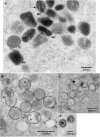Vaccinia virus A12L protein and its AG/A proteolysis play an important role in viral morphogenic transition
- PMID: 17625005
- PMCID: PMC1947960
- DOI: 10.1186/1743-422X-4-73
Vaccinia virus A12L protein and its AG/A proteolysis play an important role in viral morphogenic transition
Abstract
Like the major vaccinia virus (VV) core protein precursors, p4b and p25K, the 25 kDa VV A12L late gene product (p17K) is proteolytically maturated at the conserved Ala-Gly-Ala motif. However, the association of the precursor and its cleavage product with the core of mature virion suggests that both of the A12L proteins may be required for virus assembly. Here, in order to test the requirement of the A12L protein and its proteolysis in viral replication, a conditional lethal mutant virus (vvtetOA12L) was constructed to regulate A12L expression by the presence or absence of an inducer, tetracycline. In the absence of tetracycline, replication of vvtetOA12L was inhibited by 80% and this inhibition could be overcome by transient expression of the wild-type copy of the A12L gene. In contrast, mutation of the AG/A site abrogated the ability of the transfected A12L gene to rescue, indicating that A12L proteolysis plays an important role in viral replication. Electron microscopy analysis of the A12L deficient virus demonstrated the aberrant virus particles, which were displayed by the AG/A site mutation. Thus, we concluded that the not only A12L protein but also its cleavage processing plays an essential role in virus morphogenic transition.
Figures




Similar articles
-
Characterization of vaccinia virus A12L protein proteolysis and its participation in virus assembly.Virol J. 2007 Aug 1;4:78. doi: 10.1186/1743-422X-4-78. Virol J. 2007. PMID: 17678539 Free PMC article.
-
Differential utilization of a conserved motif for the proteolytic maturation of vaccinia virus proteins.Virology. 1994 Apr;200(1):154-61. doi: 10.1006/viro.1994.1174. Virology. 1994. PMID: 8128619
-
trans processing of vaccinia virus core proteins.J Virol. 1993 Jul;67(7):4252-63. doi: 10.1128/JVI.67.7.4252-4263.1993. J Virol. 1993. PMID: 7685413 Free PMC article.
-
Vaccinia virus proteolysis--a review.Rev Med Virol. 2006 May-Jun;16(3):187-202. doi: 10.1002/rmv.499. Rev Med Virol. 2006. PMID: 16710840 Free PMC article. Review.
-
The role of proteolytic processing in the morphogenesis of virus particles.Experientia. 1992 Feb 15;48(2):201-15. doi: 10.1007/BF01923512. Experientia. 1992. PMID: 1740191 Free PMC article. Review.
Cited by
-
Vaccinia virus A19 protein participates in the transformation of spherical immature particles to barrel-shaped infectious virions.J Virol. 2013 Oct;87(19):10700-9. doi: 10.1128/JVI.01258-13. Epub 2013 Jul 24. J Virol. 2013. PMID: 23885081 Free PMC article.
-
Activity, specificity, and probe design for the smallpox virus protease K7L.J Biol Chem. 2012 Nov 16;287(47):39470-9. doi: 10.1074/jbc.M112.388678. Epub 2012 Sep 25. J Biol Chem. 2012. PMID: 23012361 Free PMC article.
-
Transcriptome Changes in Glioma Cells upon Infection with the Oncolytic Virus VV-GMCSF-Lact.Cells. 2023 Nov 12;12(22):2616. doi: 10.3390/cells12222616. Cells. 2023. PMID: 37998351 Free PMC article.
-
Identification and characterization of Orf virus 050 protein proteolysis.Virus Genes. 2017 Jun;53(3):400-409. doi: 10.1007/s11262-017-1430-6. Epub 2017 Feb 11. Virus Genes. 2017. PMID: 28190135
-
Interactions of the vaccinia virus A19 protein.J Virol. 2013 Oct;87(19):10710-20. doi: 10.1128/JVI.01261-13. Epub 2013 Jul 24. J Virol. 2013. PMID: 23885084 Free PMC article.
References
-
- Whitehead SS, Bersani NA, Hruby DE. Physical and molecular genetic analysis of the multistep proteolytic maturation pathway utilized by vaccinia virus p4a protein. J Gen Virol. 1995;76:717–721. - PubMed
-
- VanSlyke JK, Franke CA, Hruby DE. Proteolytic maturation of vaccinia virus core proteins: identification of a conserved motif at the N-termini of the 4b and 25K virion proteins. J Gen Virol. 1991;72:411–416. - PubMed
Publication types
MeSH terms
Substances
Grants and funding
LinkOut - more resources
Full Text Sources
Miscellaneous

